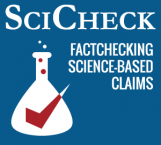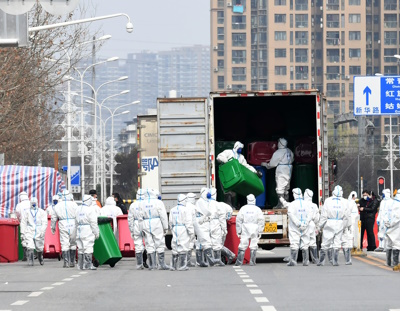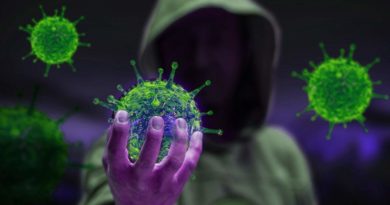Still No Determination on COVID-19 Origin
SciCheck Digest
Most U.S. intelligence agencies assess a spillover from an animal is most likely the origin of COVID-19, but recent news reports say the Energy Department now favors the lab-leak hypothesis. Online posts wrongly claim this means a lab origin has been confirmed.

Full Story
There remains no proof of how the SARS-CoV-2 virus, which causes COVID-19, originated. As we wrote in June 2021, most scientists suspect a zoonotic spillover in which the virus transferred from bats, or through an intermediate animal, to humans — the same way the SARS and MERS coronaviruses originated. But no host animal has yet been identified, and some scientists say a lab accident is possible.
In October 2021, the Office of the Director of National Intelligence released a declassified report on the intelligence community’s views on the origin conundrum, which also leaned toward a natural spillover, but represented divided views.

Four government entities plus the National Intelligence Council said with “low confidence” that natural human exposure to an animal infected with SARS-CoV-2, or a virus “more than 99 percent similar” to it, was the “most likely” origin.
One entity — later confirmed to be the FBI by its director, Christopher Wray — had “moderate confidence” that a laboratory incident “probably involving experimentation, animal handling, or sampling by the Wuhan Institute of Virology,” was the source. Three other entities couldn’t endorse either hypothesis: They leaned one way or the other, or thought both options were “equally likely,” said the report, which was based on information available through August 2021.
There was consensus in the intelligence community that “the virus was not developed as a biological weapon,” and “most” of the agencies said the virus “probably was not genetically engineered,” an assessment they made with “low confidence.” The IC also judged that China’s officials didn’t know about the virus before the outbreak in late 2019.
The report went on to lay out why the various government entities made these assessments, showing that the lack of confidence in most of the determinations was due simply to a lack of hard evidence.
“The IC judges they will be unable to provide a more definitive explanation for the origin of COVID-19 unless new information allows them to determine the specific pathway for initial natural contact with an animal or to determine that a laboratory in Wuhan was handling SARS-CoV-2 or a close progenitor virus before COVID-19 emerged,” the report said.
No information has been revealed showing either of those things — a specific zoonotic path or that a lab in Wuhan had SARS-CoV-2 or something very close to it pre-COVID-19.
However, the Energy Department has now assessed with “low confidence” that a lab accident is the more likely of the two origin hypotheses, according to the Wall Street Journal, the first to break the news on Feb. 26 of a classified report completed this year. Other news outlets have since confirmed it. The reports say the Energy Department assessment was based on new information or “intelligence,” but it’s unclear what exactly that information is.
The intelligence community’s high, low and moderate confidence levels refer to “the scope and quality of the information supporting its judgments,” a 2011 document giving an overview of U.S. national intelligence explains. “A low confidence level generally indicates that the information used in the analysis is scant, questionable, fragmented, or that solid analytical conclusions cannot be inferred from the information, or that the IC has significant concerns or problems with the information sources.”
Moderate confidence, the assessment of the FBI, “generally indicates that the information being used in the analysis may be interpreted in various ways, or that the IC has alternative viewpoints on the significance or meaning of the information, or that the information is credible and plausible but it is not sufficiently corroborated to warrant a higher level of confidence.”
Yet several social media posts have presented the Energy Department news as a smoking gun for the lab-leak argument. It’s not.
One Instagram post claimed that the Energy Department “confirms Covid came from a Wuhan lab leak,” and another wrongly stated that “US GOV finally admits that COVID started in the Wuhan Lab funded by the NIH,” adding that Anthony Fauci, the former director of the National Institute of Allergy and Infectious Diseases, had “lied.”
A Facebook post claimed there had been a “[m]assive cover-up,” an idea also pushed by Fox News host Tucker Carlson.
Actor Alyssa Milano wrote on Instagram: “OF COURSE IT WAS A LAB LEAK,” blaming former President Donald Trump for “dismantling” a National Security Council directorate tasked with responding to a pandemic. (As we’ve written, the Trump administration did eliminate a key position, but that doesn’t mean the job responsibilities were also nixed.)
Altogether, such posts have attracted hundreds of thousands of views. But they falsely characterize what we know about the Energy Department assessment.
The U.S. government hasn’t confirmed or “finally” admitted there was a lab leak in Wuhan that started the pandemic.
U.S. Agencies Divided, No Proof Revealed
Government agencies are still divided on the origin hypotheses, and the reporting so far indicates the new information, while persuasive to the Energy Department, wasn’t convincing to other agencies.
The Journal, as well as the New York Times and Washington Post, have reported, based on unnamed sources, that none of the other intelligence community entities has changed its assessment from the 2021 IC document in light of the new analysis.
Four government entities, along with the National Intelligence Council, still say the natural spillover is most likely. The Energy Department had initially been undecided on the origin hypotheses before updating its assessment, and the CIA remains undecided, the news reports say. The new classified report also confirms the earlier consensus that the agencies judge SARS-CoV-2 wasn’t created as a biological weapon.
We reached out to the Energy Department and the Office of the Director of National Intelligence about these reports, but we haven’t received a response.

The Post reported that the Energy Department relied on the “expertise of a team assembled from the U.S. national laboratory complex, which employs tens of thousands of scientists representing many technical specialties, from physics and data analysis to genomics and molecular biology.”
So, based on these news reports, the Energy Department has joined the FBI in favoring the lab accident as the most likely origin. But they remain the only ones who share that view.
“There is not a consensus right now in the U.S. government about exactly how COVID started. There is just not an intelligence community consensus,” John Kirby, National Security Council coordinator for strategic communications, said at a Feb. 27 White House briefing, while declining to confirm the news reports on the Energy Department assessment. Kirby said there was a “whole-of-government effort” to determine the COVID-19 origin and that effort was “still ongoing.”
Also, the Energy Department assessment, rather than being described as definitive, was made reportedly with “low confidence.” The Times reported: “Some officials briefed on the intelligence said that it was relatively weak.”
“Low confidence” means analysts assess one hypothesis is the most likely but they certainly don’t know for sure. “Most likely” is an estimate, not a statement of fact. The 2011 national intelligence report explains: “When the Intelligence Community uses words such as ‘we judge’ or ‘we assess’ (phrases that are used synonymously) and ‘we estimate,’ ‘likely’ or ‘indicate,’ the IC is conveying an analytical assessment or judgment. Such statements often are based on incomplete or fragmented information and are not to be regarded as statements of fact, proof, or absolute knowledge.”
In such cases, “IC does not have ‘evidence’ that shows something to be factual or that definitely establishes a relationship between two items.”
The intelligence community report released in October 2021 said all of the agencies “assess that two hypotheses are plausible: natural exposure to an infected animal and a laboratory-associated incident.” It then went through potential reasons for each hypothesis but included no hard evidence for either side. Analysts were only able to make their assessments with low or moderate confidence.
The overall assessment, at least according to the intelligence community declassified report, amounts to an informed best guess.
Here’s part of how the report describes the assessment of analysts who favored the lab-incident hypothesis: “Although the IC has no indications that WIV research involved SARS-CoV-2 or a close progenitor virus, these analysts note that it is plausible that researchers may have unwittingly exposed themselves to the virus without sequencing it during experiments or sampling activities, possibly resulting in asymptomatic or mild infection,” the report said.
Michael Worobey, head of the ecology and evolutionary biology department of the University of Arizona who has written about the origins of COVID-19, told the Associated Press it “speaks volumes” that the Energy Department’s information “apparently didn’t move the needle” for other entities in the intelligence community. He also said he didn’t think those making these intelligence assessments “have the scientific expertise … to really understand the most important evidence that they need to understand.”
Natural Spillover Research
Worobey was one of 18 scientists who, in May 2021, wrote a letter in the journal Science saying: “Theories of accidental release from a lab and zoonotic spillover both remain viable.” The letter was in response to the World Health Organization’s finding that a lab leak was “extremely unlikely.”
Since then, Worobey has co-authored two articles published in July 2022 by Science that support the natural spillover hypothesis. “The scientific literature contains essentially nothing but original research articles that support a natural origin of this virus pandemic,” he told the AP.
One of the Science articles found “the earliest known COVID-19 cases from December 2019, including those without reported direct links, were geographically centered on” the Huanan Seafood Wholesale Market in Wuhan and that mammals susceptible to SARS-CoV-2 were sold there at the time. It acknowledged that while the “exact circumstances remain obscure, our analyses indicate that the emergence of SARS-CoV-2 occurred through the live wildlife trade in China and show that the Huanan market was the epicenter of the COVID-19 pandemic.”
The researchers conducted spatial analyses using information on the first known cases of COVID-19, evidence of where live animals susceptible to SARS-CoV-2 had been sold in the market in late 2019 (including photographs) and environmental samples of surfaces in the market that had tested positive for the virus.
“Spatial analyses within the market show that SARS-CoV-2–positive environmental samples, including cages, carts, and freezers, were associated with activities concentrated in the southwest corner of the market,” the authors wrote. “This is the same section where vendors were selling live mammals, including raccoon dogs, hog badgers, and red foxes, immediately before the COVID-19 pandemic. Multiple positive samples were taken from one stall known to have sold live mammals, and the water drain proximal to this stall, as well as other sewerages and a nearby wildlife stall on the southwest side of the market, tested positive for SARS-CoV-2.”
The authors continued: “These findings suggest that infected animals were present at the Huanan market at the beginning of the COVID-19 pandemic; however, we do not have access to any live animal samples from relevant species. Additional information, including sequencing data and detailed sampling strategy, would be invaluable to test this hypothesis comprehensively.”
The second Science article from July combined simulations of the epidemic with an analysis of viral sequences to estimate that two spillovers occurred in late 2019, one in late November and the other within a few weeks, with two viral lineages of SARS-CoV-2. “As with other coronaviruses, SARS-CoV-2 emergence likely resulted from multiple zoonotic events,” the authors said, referring to the animal-to-human transfers.
If the authors are correct about the multiple spillovers, a lab origin is difficult to imagine since it would require two leaks of similar but not identical viruses in a short period of time.
Angela Rasmussen, a virologist who studies emerging pathogenic viruses at the Vaccine and Infectious Disease Organization at the University of Saskatchewan, was a co-author on the Science article pinpointing the market as the epicenter. After the news on the Energy Department assessment broke, she said on Twitter: “The available evidence shows overwhelmingly that the pandemic started at Huanan market via zoonosis.”
She said it had been one year since that article was first posted as a preprint, before it was published in Science. “No challenge to our work has yet survived peer review,” she said.
But she added in a lengthy thread: “I’m always prepared for the possibility that new evidence can falsify a hypothesis. … One piece of evidence that could change my mind would be conclusive proof that WIV [Wuhan Institute of Virology] possessed a progenitor of SARS-CoV-2.”
But that evidence “doesn’t exist,” she said. “Despite 3 years of a global search for this evidence, it has not materialized, while evidence supporting zoonosis associated with Huanan has continued to stack up.”
Rasmussen said she would “keep an open mind when and if we ever get more information about what has caused the DOE to change their assessment. … But for now, I see no evidence that suggests the current scientific evidence base is incorrect.”
The intelligence community report noted that it would “very likely” need “greater transparency and collaboration from Beijing” in order to determine the origin of COVID-19 — not only in terms of what research was being done at Wuhan’s labs but also information on the initial cases in the city and potential reservoir or intermediate animals. However, on Jan. 1, 2020, soon after the first cases emerged, Chinese officials closed down the Huanan market to sanitize it.
“China’s cooperation most likely would be needed to reach a conclusive assessment of the origins of COVID-19,” the 2021 intelligence community report said. “Beijing, however, continues to hinder the global investigation, resist sharing information, and blame other countries, including the United States.”
Editor’s note: SciCheck’s articles correcting health misinformation are made possible by a grant from the Robert Wood Johnson Foundation. The foundation has no control over FactCheck.org’s editorial decisions, and the views expressed in our articles do not necessarily reflect the views of the foundation.
Sources
Office of the Director of National Intelligence, National Intelligence Council. “Updated Assessment on COVID-19 Origins.” released 29 Oct 2021.
Goodrum, Felicia et al. “Virology under the Microscope—a Call for Rational Discourse.” Virology. 26 Jan 2023.
McDonald, Jessica. “The Facts – and Gaps – on the Origin of the Coronavirus.” FactCheck.org. 25 Jun 2021.
Sabes, Adam. “FBI director says COVID pandemic ‘most likely’ originated from Chinese lab.” Fox News. 28 Feb 2023.
Gordon, Michael R. and Warren P. Strobel. “Lab Leak Most Likely Origin of Covid-19 Pandemic, Energy Department Now Says.” 26 Feb 2023.
Barnes, Julian E. “Lab Leak Most Likely Caused Pandemic, Energy Dept. Says.” New York Times. 26 Feb 2023.
Warrick, Joby et al. “Little-known scientific team behind new assessment on covid-19 origins.” Washington Post. 27 Feb 2023.
Office of the Director of National Intelligence. U.S. National Intelligence, An Overview. 2011.
@mediaresearchcenter. “Dr. Fauci Lied, D.O.E. Confirms Covid Came From A Wuhan Lab Leak!” Instagram. 27 Feb 2023.
@GentryGevers. “US GOV finally admits that COVID started in the Wuhan Lab funded by the NIH.” Instagram. 26 Feb 2023.
Press Briefing by Press Secretary Karine Jean-Pierre and National Security Council Coordinator for Strategic Communications John Kirby. Transcript. WhiteHouse.gov. 27 Feb 2023.
Ungar, Laura and Mary Clare Jalonik. “Coronavirus origins still a mystery 3 years into pandemic.” Associated Press. 27 Feb 2023.
Bloom, Jesse D. et al. “Investigate the origins of COVID-19.” Science. 372.6543 (2021).
Pekar, Jonathan E. et al. “The molecular epidemiology of multiple zoonotic origins of SARS-CoV-2.” Science. 377.6609 (2022).
Worobey, Michael et al. “The Huanan Seafood Wholesale Market in Wuhan was the early epicenter of the COVID-19 pandemic.” Science. 377.6609 (2022).
Dr. Angela Rasmussen (@angie_rasmussen). “So…the DOE decided that SARS-CoV-2 originated with a ‘lab leak.’ The available evidence shows overwhelmingly that the pandemic started at Huanan market via zoonosis. But affirmative evidence of lab origin could change my view. What kind of evidence?” Twitter. 26 Feb 2023.
“WHO-convened global study of origins of SARS-CoV-2: China Part.” Joint WHO-China study. 30 Mar 2021.
This article has been archived for your research. The original version from FactCheck.org can be found here.


